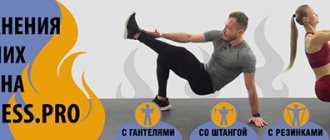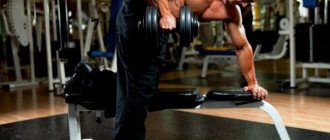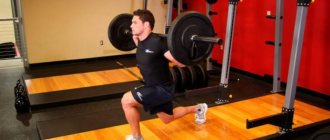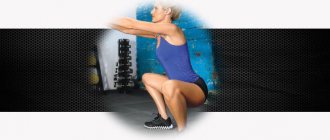Squats 20 reps
Without any significant reason, I am now writing this article on this topic, plus this topic will not be new at all. Nevertheless, I am writing this. By the name, you already guessed that we are talking about squats for 20 repetitions (sometimes this exercise is called breathing squats). This is something like an original training based on the rest-pause principle, so they even wrote a whole book about the topic, “15 kg in 6 weeks,” and it’s clear that most of this will definitely not be muscles, you know.
But I’m not going to write this article like everyone else. I want to take a look at this principle of training in a general sense, that is, how it is performed, and also look at the various implementation options and some of the nuances that many almost never worry about. I am sure that we will also touch on related topics, I have such a bad habit.
What are 20 rep squats?
So
If you think this is a typical 20 rep squat set, you're wrong. As I said earlier, this is part of the rest-pause training principle, you'll see something like "pick a weight that you'll do 10 reps with and then complete the set for a total of 20 reps with that same weight." Let's first analyze this phrase. A reasonable person will immediately understand that if you take a weight with which you can only perform 10 repetitions, then there is no way you can do 20 repetitions, this is called a repetition maximum (RM). And if you can do 20 reps with the weight, then you've done 20 RM. If you took a weight that you were doing 10RM with, but did 20RM, then you rested a long time between the next reps. And this is not at all the principle that is assumed in this concept.20 rep breathing squats
The concept We did a repetition, breathed three times, did a second repetition, breathed again three times, did a third repetition and again three breaths. I think you understand. I believe that these inhalations and exhalations will give you enough time to rest between repetitions and get to the 20th repetition. But I honestly doubt it, it seems to me that in the end you will need more inhalations and exhalations; I'll be honest with you, I haven't done this exercise in this style, so I can't say for sure. But the main idea here is to take deep
breaths after each repetition. Typically, these squats were accompanied by light breathing pullovers to “expand the chest.” This is usually called breathing squats. Next I will describe to you a more common technique.Traditional 20 rep squats
Probably
That is, how you usually squat, nothing complicated. And then, when the process begins to slow down, then start breathing more often between repetitions, inhale and exhale a couple of times and repeat again. We breathed again and did it again. The farther you go, the closer you will get to your maximum; in principle, each repetition will be on the verge of your maximum, accordingly you will increase the number of breaths, but it will be up to you to determine their number. It is quite possible that at the end you will take 10 breaths to complete the last repetition. Keep your head elevated and chest open; if you lower them, there is a chance that you will not return them to the starting position. You will stand under a heavy barbell and greedily grab oxygen into your lungs; from the outside it will seem as if a train is passing nearby.This will be a long set, probably several minutes. So, under the weight of the barbell, be prepared that your shoulder girdle will be completely exhausted, your arms will get tired, and when all this hell is over, you will fall to the ground and want to rest a little, usually for 5-15 minutes. If you have a thought in your head to complete the second set, then you did the first one incorrectly. A little later I will describe this concept to you in more detail, but for now I will say this: 20 rep squats, basically, were part of a full body program (full body), so certain upper body exercises were performed after
main set.
To break up this boring text, here is a video below of Jesse Marund demonstrating the correct technique for performing this exercise. Notice how quickly he does the first half of the repetitions and how many inhalations and exhalations he has at the end of the exercise. Well, he then lay down to rest.
20 rep squats. Method one
What
20 rep squats used to be used as an epilogue to a workout. As a separate concept, “twenty repetitions” emerged much later. This is a fairly common technique that has been used for many years, in fact now too: after your heavy pulling workout, follow a volume or pump workout. McCallum would recommend doing 3 heavy sets of 5 reps, followed by 8 sets of 8 reps with 30 seconds rest. This is how squats were performed. Initially, you would have to squat 5 sets of 5 times, and before that you did 3 warm-up sets and 2 “finishing” sets, well, maybe 2 warm-up and 3 maximum. And then the weight dropped and you had to squat those same 20 times. Then you lay down and rested for a while. As a rule, the weight also had to progress, the weight on the bar, naturally. Therefore, we strived to increase it in almost every training session.I once trained in this style for several months. I did 5 heavy sets and then achieved. I used to be a sucker for heavy low rep training ala Hardgainer and John Christie (may he rest in peace), so it would go something like this: warm up, 2 heavy sets of 5 reps with about 5 minutes rest, and then I'd lower the weight and do 20 reps squats. After all this, I went to rest and then completed the main work on the upper body.
Just then I experienced panic attacks when I walked from the car to the hall. In fact, the training was almost always near the maximum, like walking on the edge of a knife, and I had been training using this method for quite a long time. And I remember that day quite clearly, I did my 5s, then dropped the weight on the bar, looked at it and... and that’s it, I took it apart. This was the end of my 20-rep style training.
20 rep squats. Method two
And
I did this workout once, but whether I will ever do it again I dare not say. It was the worst 20-talk I've ever done. It starts out simple enough, with 20 reps of squats, but my teacher was a stickler for interesting things. Lowering and rising slowly, you should squat as low as possible and breathe correctly. Because after 20 reps you will be given penalty reps. That is, you will redo every repetition that he considers was performed incorrectly. There may not be any, or there may be about twenty. I think in my case I only did a few reps. Tough...that was already 20 years ago.After the penalty reps, you are left with a finishing goal: complete 5 more reps, or go down, pause on the way up, and then very slowly go back down again. After all this, you can lie down and rest.
At best, you will do 25 repetitions, this is if you did everything correctly and there are no penalty repetitions. That is, 20 main ones and 5 last ones. If the technique is poor, the repetitions will increase. I don’t recommend this at all, honestly, but I needed to write to you about something today.
Correct execution of 20 repetitions of squats
We’ll probably finish you don’t
need to do 20 repetitions of squats. From the above, it became clear that, most often, they first do 10 repetitions, and then achieve up to 20. This is almost correct, BUT (!) Never, NEVER, NEVER try to start doing 20 repetitions immediately by lifting a weight at which you are doing only 10 repetitions.If you are not equipped for high repetition training, then this is a recipe for destruction and disaster. Over time, your lower back or upper back will become so tired that you will break the technique so much that you may die (okay, maybe you won't die) and then problems may begin. In any case, then you will definitely want to die.
First, do a few introductory workouts with a weight that is far from your 10RM. Let's say you train your 10RM at 75%, then drop down to 60-65% (or just lower your working 10RM by 10-20%) and gradually increase the weight during your training. Yes, definitely, the duration of the progression will depend on the duration of the cycle itself, but, nevertheless, take my word for it, you don’t need to start from the maximum, let introductory training be a mandatory criterion, so you will prepare yourself both physically and mentally.
If you take into account the previous warnings, then customizing the 20-repetition program is quite simple. Complete the approach, then, when you have done 20 repetitions with this weight, add 2.5 kg per barbell in the next workout. The main goal is to add weight in each workout (and, of course, if you couldn’t do 20 squats in a workout, then don’t add weight). It is sometimes recommended to squat with light to medium weights without progression, and in fact, some people swear that this approach helps them grow bigger legs.
I'm sure there are maniacs who recommend doing 20 squats 3 times a week, but in this case, most people simply cannot handle this load even twice a week, physically or mentally. But it is quite possible to train like this once every 5 days; for most this will be the best option.
But most people don't really like this training scheme, so if you do 20s once a week (for example, on Monday, when you've recovered from the weekend) and combine them with a traditional leg workout (or an easy workout) on Friday. I think this is the best option. Your lower back will receive a lot of stress, especially if you sit low.
As for the duration of such a training course. As you remember, in my case the cycle was long and it...you know what it led me to. So 4-6 weeks, at best 8 weeks (that is, 2 months) with 2-3 weeks off is a great option. This will give you a real workout for 5-6 weeks, then 3-5 weeks of recovery training, and then you can move on to strength training or hypertrophy, whichever you want.
In those days, 20 repetitions were performed as part of the fulbadi program. First, perform 20 repetitions, then pullovers and add a base for the upper body. I honestly doubt that the athletes will be happy with this approach, so train the upper body (yes, the entire upper body) on another day. Monday/Thursday, 20 reps on Monday and upper body (YES, ENTIRE UPPER BODY!) Tuesday/Thursday would be a reasonable split.
It is also worth pointing out the differences between the sexes. I can't remember exactly whether the girls were recommended to do 20 reps or not, but they weren't participating in the popular "weight gain" game back then. On the other hand, women have better endurance when working with submaximal repetitions, plus they are not injured by it. However, their upper body is often more limited to work with multi-joint exercises/movements, and this will be the main problem.
Other variations of 20 rep squats
There are
In one of Milo's options, he is asked to perform 20 repetitions of “good morning” (MD). But be careful. Just like in squats, you can break your technique due to fatigue, but in remote control you can also injure your lower back, and more quickly. And back pain is not the most pleasant pain. I've seen people do 20 reps on the bench press, but you'll rarely see this type of training.And finally, here's something else I don't recommend. In “Hardgainer” they recommended 20 repetitions in the deadlift. But it seems that even the author himself was injured as a result.
Just like the remote control, the deadlift can later cause considerable problems, because with high repetitions the technique begins to break down. To be honest, I only trained in this style once. Just once. You yourself know how many people turn their backs. This can often be found in women, due to the fact that their upper body is much more limited.
Results for 20 rep squats
Now
As you can see, there are a large number of really wild variations and perverted applications. Having tried at least one, you will feel the essence of how prepared (or not prepared) you are for the type of load. It’s better to never use long cycles at all, because they will suck your entire soul out of you. If you have already decided to do reasonable training, then train wisely, in short courses, and then follow the established pattern, depending on your goal. How many repetitions to do in a set is a very important question. The result you get from training depends on the number of repetitions. In this article I will try to answer this question as accurately as possible. And you will be able to correctly determine the rate of repetitions based on your own goals.To get started, check out this diagram. And below I will give all the explanations.
What is a rep max?
This indicator will help you better understand the topic. It is usually denoted PM or simply indicated that the weight is 100%.
Repeat max
- this is a specific weight that you can lift in a given exercise only once. Be sure to be technically pure (no cheating or other tricks). Adding even 100 g to this weight makes this weight too heavy for you.
If it is written that the weight is 90%, then we are talking about a weight that is 0.9 of the repetition maximum. If your rep max in the barbell squat is 70kg, then 90% of it will be 63kg. Got it? Go ahead.
Number of repetitions. We clearly separate the zones.
1-3 reps
This number of repetitions increases one-time strength. Here we use the heaviest weights (90-105% of the maximum, but there are exceptions - someday I’ll tell you about the method of low-repetition explosive training with light weights). Don't be surprised, 105% is common in powerlifting strength training. This is a normal practice that allows athletes to quickly achieve new results.
In this range, such parameters as coordination of movements (an important thing for the development of one-time muscle strength) and innervation of motor units (these are groups of muscle cells innervated by one motor neuron) develop powerfully.
Heavy weights instantly force the body into optimal positions and exhibit optimal biomechanics.
And motor units are generally a very interesting thing. Pure strength training “teaches” muscles to recruit as many motor units as possible simultaneously, in one repetition. This synchronization manifests itself as a one-time force.
This method best develops white muscle fibers.
4-6 reps
This number of repetitions is performed in sets to develop muscle power and explosive strength (see also). Typically, weights of 80-85% of the repeated maximum are used.
Sets of 4-6 repetitions are optimal for developing explosive strength and power of movements. However, this method does not grow records in single repetitions as effectively as training with 90-105%, despite the fact that it also develops white muscle fibers well.
6-8 reps
This is a very convenient and comfortable number of repetitions for muscle growth. The optimal weight is 70-80% of the repeated maximum. I remember making the most progress on the front squat at this number of reps. A higher number of repetitions led to an acute lack of oxygen and premature termination of the set.
This range is believed to be optimal for the development of myofibrillar muscle hypertrophy. That is, muscle myofibrils (contractile elements of muscle cells) develop (increase in thickness). Basically, white muscle fibers respond well to this number of repetitions.
The range is very good and comfortable. However, it feels like if you “sit” only on it constantly, there is no development of endurance (it literally evaporates) and even a regular run of 2-3 km or a couple of rounds in the ring becomes a cruel test for the respiratory tract and the heart.
9-12 reps
Many people believe that this amount is too high for muscle growth and classify this range as endurance. After all, here we are dealing with weights of the order of 65-70% of the repeated maximum. When training with such weights, red muscle fibers are actively involved in the work.
However, practice and some studies indicate a significant mass-gaining effect in the range from 10 to 18 repetitions. This contradicts the opinion of staunch supporters of pure strength training, aimed at 6-8 repetitions. In addition, after many years of training at a low number of repetitions, training for 12 or more repetitions is very uncomfortable. Many athletes confuse this feeling of discomfort with a lack of effect.
In the range from 10 to 18 repetitions in the muscles, there is indeed no active growth of myofibrils in thickness. However, there is a significant increase in sarcoplasmic volume, which directly affects muscle size and strength endurance. This does not increase one-time muscle contractility, but the functional component (the ability to work intensively and for a long time) increases significantly. Therefore, the opinion of convinced supporters can be easily moved and expanded if we are talking specifically about the growth of muscle mass.
In addition, do not forget that the growth of muscle mass is influenced by many training parameters: (and, accordingly, the number of approaches), increase in working weight, etc.
12-15 reps
It is considered the optimal number for improving the shape and relief of muscles. Typically, weights in the range of 55-65% of the rep maximum are used here. The muscles work mainly with red muscle fibers.
This range really improves the shape and relief. But a lot depends on nutrition. If you make it mass-gaining, your mass will grow very well.
15-25 or more repetitions
According to established ideas, this is a zone of almost exclusively growth and improvement of their relief. If you work with iron, then with this number of repetitions, weights in the region of 55% of the repetition maximum and below are used. The muscles work almost exclusively with red muscle fibers, which are responsible for endurance. And also for burning fat.
Be sure to keep in mind that such training takes a very serious toll on one-time strength, quickly reducing it.
It is for this reason that people who practice the so-called healthy lifestyle - regular long running and simple exercises with their own weight for many repetitions, and often radical forms of vegetarianism (God forbid!) do not like “iron” or limit it to a minimum. And completely in vain, by the way! Iron is a very powerful health stimulant and, unfortunately, the subject of huge misconceptions among older people...
Well, we've covered all reasonable rep ranges for strength training. Now let's see why it is worth moving away from the clear boundaries of these ranges.
The response of the muscles and the entire body to these ranges involves different mechanisms and adaptations. And often a certain adaptation begins to manifest itself in one zone, is maximally manifested in another, and sometimes its signs are present in a third, etc. repetition zones. That is, many parameters are not uniquely related to a specific number of repetitions.
When it comes to pure strength training for repetitions, the best way here would be to perform single repetitions with maximum weights. However, even if you train for 6-8 repetitions, one-time strength will also increase. But not so fast. After all, 6-8 repetitions are not optimal for this.
It’s also worth remembering about relief training, when you need to “burn” extra pounds. It seems that here you just need to do a lot of repetitions. But it’s not necessary!
There are many training methods that allow you to burn fat quickly by training with relatively heavy weights and low reps (8-12). We are talking about methods such as, etc.
Of the hundreds of bodybuilding exercises used these days, the squat's potential far surpasses all others. A training method based on squats consisting of twenty squats was invented a long time ago. According to Randal Strossen, who first thoroughly described it in his 1989 book Super Squats: How to Gain 30 Pounds of Muscle in 6 Weeks, this technique guarantees muscle gain. mass even with the most fragile physique: trainees who could not make significant progress suddenly added more than 5 kg of muscle in a month or two.
Basis of the technique
:
|
Additional exercises are unimportant, two or three sets of a few other basic exercises is the maximum, and the general thing to be wary of is doing too many additional exercises rather than too little.
The whole secret of the technique is in the features of squats
:
|
|
How to do squats for 20 reps
- Hang the weight you're doing 10 reps with on a barbell, wrap a towel around it to give a little padding for your shoulders and back, lift the barbell off the rack, take a step back, take two or three deep breaths, and do your first rep. Nothing special, just a regular squat until the upper thigh is parallel to the floor. By the fifth rep, you'll be properly warmed up, squatting smoothly, and deep breathing will come naturally.
- After the tenth repetition, your body is exhausted and your mind is like a car that is either moving or stuck in its motion by the twentieth repetition. At least three deep breaths, a lot of positivity, and the eleventh rep was history.
- A little more of the same for the next one or two reps and then the breathing and attitude become more serious. There may be five to ten lung-shattering breaths between reps, your mind is close to hallucinating and your determination is ninja-like, and you're up to the fifteenth rep.
- Now the rules of the game change again, because it is no longer breathing and encouraging yourself that plays a role, but each squat becomes an event inside a capsule, cut off from time, where you as a being disappear, turning into an observer, and not an actor. If your sanity falters, you are lost, so either grow strong and grow, or give up and stay small.
- By the sixteenth rep, the bar digs deep into your back and presses your entire body into the floor, giving you a new understanding of the laws of gravity. Your breath sounds like a steam engine and your legs are likely to start shaking. Pure will is the only way to do this repetition. Don't forget that this was all just a warm-up for the remaining few reps - these are what will make you grow - and you are blind to everything except the pattern: breathing, squatting, getting up.
- By the time you finish the eighteenth rep, you are guaranteed to finish the set if you set your mind to it correctly, because what was most important to you in life—doing 20 reps—is already in your sights. It doesn't matter that each of the last two reps will take ten breaths, send you into a frenzy, turn your face purple, and leave you shaking on the way up through the sticking point of each squat. You're not going to miss out on a win.
Training programs
Below are a couple of workout options that will set you on the path to a stronger, bigger body and provide exercises that promote better health. For each of these programs, start with moderate weights and increase them gradually.
The first program worked wonders on bodies that had refused to grow under countless other programs.
| PROGRAM 1 |
| Bench press 2x12 |
| Squats to parallel 1x20 |
| Pullover 1x20 |
| Bent-over row 2x15 |
Infinite growth in this or any other way is impossible. One of the best ways to make continuous progress is through alternating programs, which often proves to be just as refreshing as a period of complete rest. Thus, the key to successful training planning is:
- alternating programs that complement each other, but are different enough to give the body and mind an invigorating sense of newness.
| PROGRAM 2 |
| Clean 5x5 |
| Alternating dumbbell press 5x5 |
| Incline Bench Press 5x5 |
| Chin row 5x5 |
| Squats to parallel 5x5 |
| Leg raises 2x25 |
| Alternate dumbbell curls for biceps 5x5 |
How often to exercise
Some manage to work using this method three times a week, every other day. Some people prefer to train twice a week, such as Mondays and Thursdays. And some found that they did not have time to fully recover during such training and, therefore, trained once every 5-7 days. Adjust the program taking into account your individual qualities.
How to eat according to the method
In addition to doing 20 reps of squats, trainees are advised to eat plenty of healthy foods, drink at least two liters of milk per day and get plenty of rest between workouts. That's it: one set of squats for 20 reps, a couple of other basic exercises, plenty of food, milk and rest!
Based on the book: Strossen RJ (1989). Super Squats: How to Gain 30 Pounds of Muscle in 6 Weeks. IronMind Enterprises Inc. [read in Russian translation]
2013 © Bodybuilding for hardgainers
How many repetitions do you need?
If you are a beginner (poor shape and no training experience, plus, possibly, extra pounds)
Do simple bodyweight exercises for 15 or more repetitions. Try to increase this number to 40-50 or more. Examples of exercises: squats, forward bends, etc.
If you are a beginner (training for less than 3-6 months)
Perform strength exercises for 12-15 repetitions. Try to gradually increase your working weight.
If you have an average level of training (train for 6 to 12 months)
You should think about periodizing your training. This is a simple alternation of sets of exercises with different numbers of repetitions. You will definitely benefit from 6-8, 12-15, and 15-25 repetitions. And it would be better to divide them into different sets of exercises performed in different months of the year.
If you have extra pounds (but are at least somewhat mobile)
Start practicing high-repetition simple bodyweight exercises. Do 20-40 or more squats per set. Do a lot of inclines (20 or more per set). It is this method that has proven itself well in my training.
If you are underweight or are an ectomorph (and already have at least 3 months of training experience)
Do sets of 4-6 or 6-8 reps. This will allow you to grow muscles and gain weight as quickly as possible. No amount of push-ups or running will help here. What you need is strength training and a very nutritious diet. And rest more between sets. The workout will be longer, but the “meat” will grow effectively.
If you are over 50 years old
It is recommended not to use low repetitions (1-6) in training. More precisely, use it rarely, as peak training once every 2-4 weeks. However, you shouldn’t give up strength training altogether. Over the course of a year, you should have 2-3 complexes for 1-2 months with the number of repetitions from 6 to 10. This is extremely important precisely because of age, when muscle mass is actively lost, and with it the remnants of health.
I wish you successful studies! Questions and comments are welcome.
Fixed limit of 100 reps
Do you want to learn how to train effectively and constantly progress? Then read the article “Fixed limit of 100 repetitions”...
It has long been no secret that a large training volume is the best thing you can think of for constant muscle growth.
Of course, I like various high-intensity workouts, but only volumetric training, like no other, includes in my work and perfectly works not only large muscles but also deeper small muscles, making your muscles much better quality. I was once asked what I think is the ideal number of repetitions to perform in an exercise? I said that the ideal number of repetitions is 100 repetitions. Moreover, this number of repetitions applies to absolutely any basic and isolated exercises.
In my opinion, this is exactly the number of repetitions at which both large muscle groups and small deeper muscles are well worked, which are usually very difficult to work with a small volume.
In this case, it does not matter at all how many working approaches you perform in your exercises. The most important thing is to complete the total number of repetitions that you will need to perform in a particular exercise.
Here the main task is to complete all 100 repetitions, and how you do this is completely unimportant.
Because you can perform 5 sets of 20 repetitions, or you can perform 10 sets of 10 repetitions, or even perform as many as 20 sets of 5 repetitions. In both cases, you will get 100 repetitions.
It is worth understanding that such a breakdown into approaches should have some kind of logical component.
Because it will be very stupid if you start your cycle right away by doing 20 sets of 5 repetitions, when in fact you have just started your cycle, and all your working weights are quite small.
Well, as they say, stupid thoughts only come to stupid heads...
I believe that everything has its time. And you also need to break down your approaches sequentially along with the increase in your working weights.
Total sets/repetitions ratio:
Phase #1 Start of 100 rep cycle: 5 sets = 20 reps per set
Phase #2 Mid cycle 100 reps: 10 sets = 10 reps per set
Phase #3 End of cycle 100 reps: 20 sets = 5 reps per set
In this case, it is worth considering not only the time of each exercise, but also your entire workout as a whole. Do not forget that the faster you complete the total number of repetitions in each exercise, namely 100 repetitions, the shorter and therefore more intense your workout will be.
Therefore, from the very beginning you should take care to determine for yourself the time limit that you will adhere to throughout your cycle.
If you complete 100 repetitions not in 20 minutes, but let's say in just 10 minutes, i.e. 2 times faster, then accordingly your intensity level will also be 2 times higher.
Determine for yourself in each of your exercises what time you will stick to and how long it will take you to complete 100 repetitions and always try to stick to this time.
For example, if you can perform 100 repetitions of an exercise in just 10 minutes, then in the future in all your workouts you will always have to adhere to the given time limit that you have set for yourself.
At the same time, you can always complete your exercise before this time limit of 10 minutes, but not later...
The ratio of the total number of sets/repetitions, as well as the total time limit of 10 minutes (600 seconds):
Phase #1 Start of 100 rep cycle: 5 sets = 20 reps per set
10 minutes (600 seconds) : 5 sets = 2 minutes (120 seconds) rest and time to complete a set of 20 reps
Phase #2 Mid cycle 100 reps: 10 sets = 10 reps per set
10 minutes (600 seconds) : 10 sets = 1 minute (60 seconds) rest and time to complete a set of 10 reps
Phase #3 End of cycle 100 reps: 20 sets = 5 reps per set
10 minutes (600 seconds) : 20 sets = half a minute (30 seconds) rest and time to complete a set of 5 reps
You can also determine for yourself the required number of repetitions, approaches and time to complete each exercise.
This method allows you to work very intensively both at the very beginning of your cycle and at the end of the training cycle. After just one such training cycle, you will notice not only an increase in muscle mass, but also an increase in strength, not to mention endurance...
All these techniques are very effective and are actively used and used not only in bodybuilding, but also in other sports.











